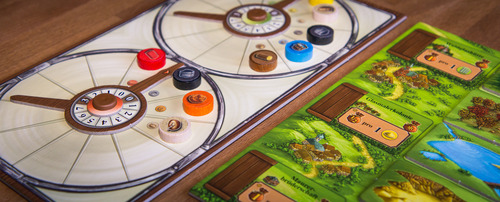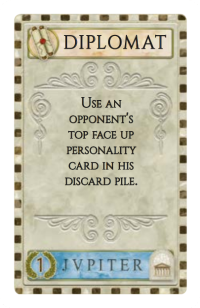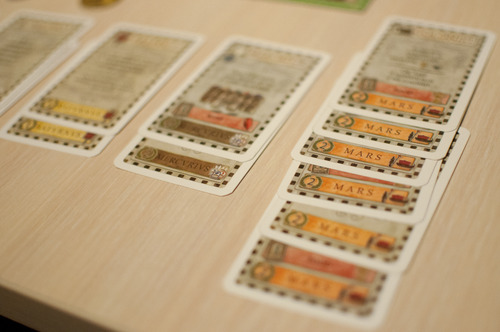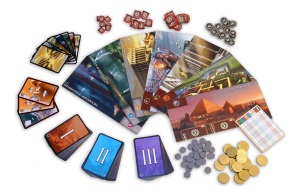In Glass Road, players keep track of their resource stocks on circular tracks called production wheels. So, rather than having a bunch of tokens for each resource, players move a few tokens around the wheels. This isn’t very original in itself: many games have you keep track of resources on tracks—although usually the tracks aren’t round.
The originality comes from the ‘production’ in production wheel. Players each have two: one that produces brick and the other glass.
Two hands separate each wheel into two sections—kind of like a clock. The hands are attached together: when you move one the other comes with it and they are always the same distance apart from one another. The smaller section represents the current stock of the resource being produced. Whereas the bigger section represents the stock of all the basic goods needed to produce the said resource. For example, on the brick production wheel, you would have your brick token in the small section then clay, charcoal, and food tokens in the bigger section. At a glance, everyone can see everything they need to know about each other’s stocks and production potential.
Some goods—like food—are used to produce both brick and glass. When players get such goods, they must decide which production they want to invest in. For example, if you get some food you can either move your food token on the brick producing wheel or the glass producing wheel.
Around the centre of each wheel are numbers. Each section has its’ own set of numbers: the big basic goods section ranges from 0 to 7 and the small produced resource section ranges from 0 to 3. The numbers of both sections start on either side of the same hand and go around the centre in different directions. All this is set up so that when a wheel is turned to the right the stock of basic goods decreases while the stock of the produced resource increases. This makes the fiddly process of exchanging a bunch of goods for another really fast and easy: genius.
Now for the cherry: production is automatic. As soon as the hands can turn, they must be turned. So, there is no slow process of resource transformation in Glass Road. It just happens! As you can imagine, timing when production occurs is one of the most important ponder points of the game. Sometimes you really need some clay but if you get some, the brick production wheel will turn and you will lose the food that you also need. It’s worth leaving one basic good low—blocking production—if you want to stock up on another.
All in all, the production wheels are packed full of great ideas. They create lots of interesting decisions that shouldn’t be taken lightly if you want a shot at winning. Check out Glass Road if you get a chance: I didn’t even talk about how fun the card play is :).
What do you think of this one? Have you seen production wheels in other games?



















